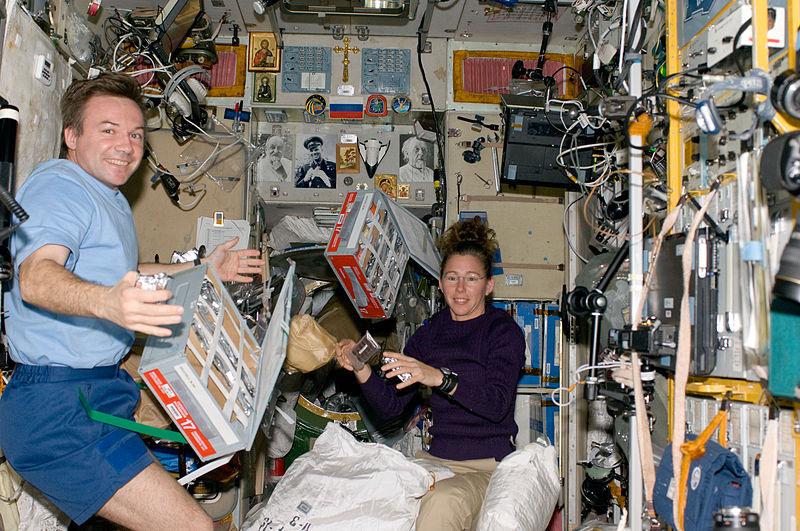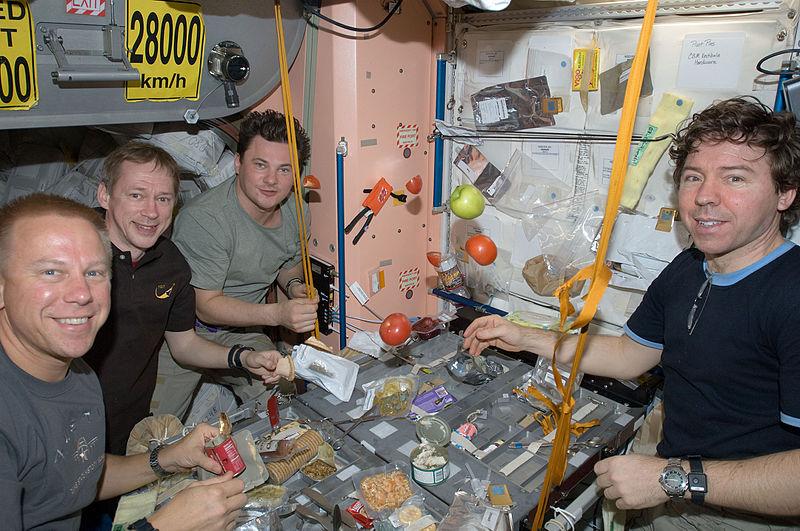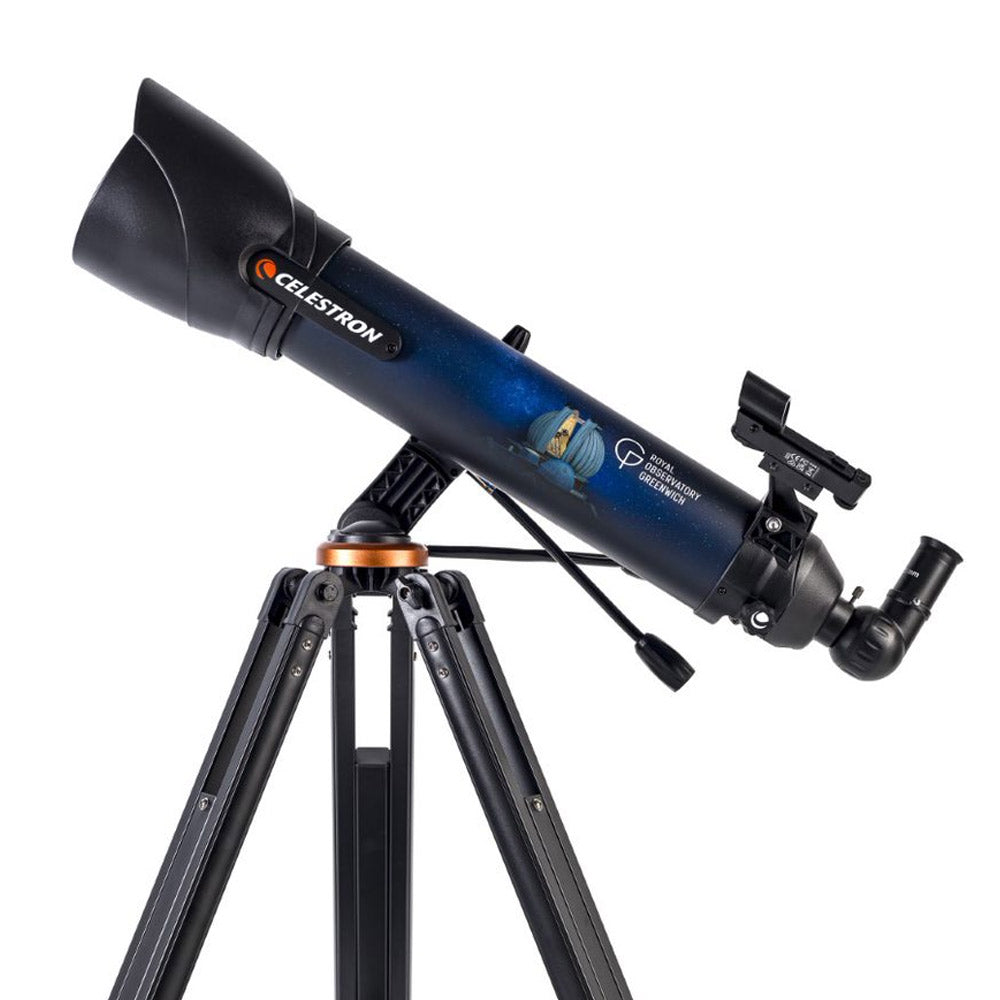
Today, astronauts eat a varied diet that is similar to what we eat on Earth. The menu aboard the International Space Station (ISS) includes more than a hundred items - from vegetables and fruit to pre-prepared meals and desserts. Even condiments such as ketchup and mustard are available. There are three meals per day, plus snacks that can be eaten at any time, ensuring astronauts receive at least 2500 calories each day.
Foods taken into space are pre-planned by the mission team and are often chosen from a menu by the astronauts themselves. To allow astronauts to stay in space for long periods, scientists have invented unique ways of packaging and preparing produce and meals. When planning which foods will be sent, scientists and Mission Control choose ingredients that are light-weight, nutritious and easy to eat while also remaining tasty.
Eating in space
There are numerous challenges to eating in space and low gravity conditions - not only the primary issue of getting the food from the package into astronaut's mouth.
There are many health considerations. Over long periods in space, muscle mass and bone density can decrease by up to twenty per cent. This loss may not hinder astronauts while they are in orbit, but their weakened bones can prove fragile when they return to Earth, increasing the risk of fractures. Exercise and foods rich in calcium like yoghurt are therefore essential.
As fluids act differently in space, an astronaut’s sense of taste is changed. On Earth, body fluids generally settle towards our feet. In reduced gravity, these fluids move freely in our bodies, creating a similar feeling to a head cold or blocked sinuses and leaving many foods tasting bland. To reactivate their taste buds, many astronauts to have a preference for piquant and hot foods such as peppers and spicy flavours such as horseradish or wasabi.
First bake in space
In December 2019 the first cookies were baked in space. The cookie dough was provided by DoubleTree by Hilton, and was baked on board the International Space Station, taking two hours in the oven.
We made space cookies and milk for Santa this year. Happy holidays from the @Space_Station! pic.twitter.com/sZS4KdPmhj
— Christina H Koch (@Astro_Christina) December 26, 2019
How do astronauts eat in space?
Food and drink are packaged using similar methods to those used in other forms of long voyage, especially those undertaken by the military. Primarily, zip lock bags, retort pouches and cans are used due to their light weight, compact size and airtight seals, which prevent spoilage and spillage.
Food is prepared using microwaves and convection ovens. At the water stations, a water gun reconstitutes dehydrated meals and fills water bags. When an astronaut chooses their meal, they scan a barcode found on the back of the meal's package. This allows their mission team to keep track of what they are eating.
Aboard the ISS, a dining room with tables and chairs fixed to the floor allow for a more normalised dining experience. Astronauts strap themselves into chairs with thigh and foot supports and eat from magnetised trays using forks, knives and spoon. Antimicrobial materials line the walls in the room, preventing the spread of bacteria.
What foods are eaten in space?
Historically, space food was mainly dehydrated or provided in pastes and eaten from tubes. As science and technology have provided us with new forms of food processing, packaging and ingredients, the foods have also improved to now resemble many meals we have on Earth. When planning which foods to send into space, they are divided into the following groups:
Fresh foods - produce with a two-day shelf life such as fruit and vegetables are refrigerated onboard the spacecraft and consumed quickly to avoid spoilage. As vitamins and nutrients can generally be satisfied by other means, this produce is sent to keep morale high.
Irradiated foods - meat and dairy produce have ionising radiation applied to them before packaging. This increases the items’ shelf life and reduces the risks associated with microbial contamination.
Intermediate moisture - these foods contain a small quantity of water (low enough to limit microbial growth) and are often soft in texture. Processes such as salting or sun-drying are used in the creation of these items and require no further preparation.
Natural form foods - foods such as nuts, biscuits and chocolate bars are simply packaged and ready to eat.
Rehydratable foods and drinks - for a long time, this was the standard method of preparing food for space. Removing the water from the food or drink makes it difficult for bacteria to multiply and dramatically extends the product’s shelf-life and reduces the chance of spoilage. These products have water returned to them when the astronauts are ready to eat.
Thermostabilized - heat-treating is used to prepare many of the ‘ready meals.’ Bacteria is killed off in this process by applying heat and then quickly sealing the product in air-tight packaging.
What food is eaten on the ISS?
Every two months, an automated spacecraft, such as the European Space Agency's 'Automated Transfer Vehicle' or the Russian's 'Progress' spacecraft, dock with the ISS loaded with fresh fruit, water and pre-packaged meals.
To build comradeship between the different nationalities aboard the ISS, astronauts choose from a broad menu of foods from their country which are shared with their teammates. For example, the Japanese Aerospace Exploration Agency (JAXA) have invented a rehydratable noodle and China created specially processed Kung Pao chicken.
In 2014, the Italian Space Agency (ASI) created the ISSpresso, a coffee machine specially designed for space and low gravity conditions. The first espresso coffee was drunk in space by astronaut Samantha Cristoforetti on 3 May 2015.
First food eaten by astronauts in space
In 1961, Yuri Gagarin became the first man in space and the first person to eat in space. Aboard Vostok 1 on 12 April 1961, Gagarin ate beef and liver paste from an aluminium tube by squeezing it into his mouth. For dessert had a chocolate sauce, eating the food by the same method.
How do astronauts drink in space?
As water would float away from the container in microgravity, drinking fluids in space require astronauts to suck liquid from a bag through a straw. These bags can be refilled at water stations through a low pressurised hose.
What do astronauts drink in space?
Astronauts mainly drink water while in space, but flavoured drinks are also available. Freeze-dried drink mixes such as coffee or tea, lemonade and orange juice are provided in vacuum sealed pouches. The astronauts then add water to the beverage pouch through the pressurised hose and suck the drink through a straw.
Can astronauts drink alcohol in space?
Edwin 'Buzz' Aldrin remains the only astronaut to drink alcohol in space, and more significantly on the Moon. As the Apollo 11 lunar module sat on the Moon’s surface and before Armstrong and Aldrin descended, he completed Holy Communion.
Find out more about the Apollo 11 crew
NASA has banned consuming alcohol on any space missions. This is because it is critical for the astronauts crewing the spacecraft to be on alert and able to react quickly to any contingency.
How has the food that astronauts eat changed?
Space food has come a long way since Yuri Gargarin's paste in tubes.
Today, astronauts have a range of food and beverages to choose from. On the ISS, food is delivered refrigerated or dehydrated once every 90 days, which can be cooked in microwaves or convection ovens. Different nations aboard the ISS provide their traditional courses and snacks, helping the crew to share their cultures while having a taste of home.
How do astronauts dispose of waste?
In low gravity conditions, bacteria can spread quickly, so cleanliness is a critical factor when considering space travel. After eating, astronauts dispose of their food packages and waste in a trash compactor under the shuttle floor. They clean cutlery and trays with wet wipes.
Without a septic tank or sewer system, shower and toilet waste also need somewhere to go. Because of the low gravity environment, the toilets onboard use air instead of water to flush. The air in the toilet is filtered to remove bacteria and odours and is then returned to the living cabin. Solid wastes are stored onboard until the shuttle lands, and liquid wastes are sent out into space.






